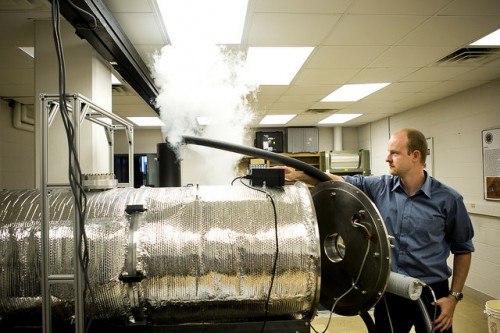
The search for evidence of water on Mars, past or present, has been one of the driving forces behind the exploration of the Red Planet for several decades now. While orbiters, landers, and rovers have all found abundant evidence for a lot of water in Mars’ ancient history, the question of whether there could still be any of the wet stuff existing today is still open and unanswered. There are hints, but proof is still elusive. Now, a new study provides new information on how liquid water could be found on Mars’ surface today, albeit in small amounts or for brief periods of time.
For water to become liquid in Mars’ thin and cold atmosphere, a key ingredient is needed: salt. This has been proposed before, with the idea that salts, commonly found in the Martian soil, could suck water vapor out of the atmosphere through a process called deliquescence. The new study, by researchers at the University of Michigan, suggests, however, that the salts would need to physically touch water ice, also abundant on Mars, in order to form liquid.

This process would help to explain some mystery droplets which were observed to form on a landing leg of the Phoenix spacecraft, which landed near the Martian north pole in 2008. They looked liked beads of water which formed, grew, and then later sublimated away. The theory is that the landing thrusters on Phoenix heated ice, a large patch of which was seen directly under the lander, which then partially melted and mixed with salts in the soil. Some of this briny “mud” splashed onto the landing leg. Indeed, later analysis of the soil found calcium perchlorate, a salt which is a mixture of calcium, chlorine, and oxygen that’s found in arid places on Earth such as the Atacama Desert in Chile.
“For me, the most exciting thing is that I can now understand how the droplets formed on the Phoenix leg,” said Nilton Renno, a professor of atmospheric, oceanic, and space sciences who led the research experiments.
While this occurrence was caused by the landing of Phoenix, it shows that any time these salts come in contact with ice, they could melt the ice enough to allow liquid water to temporarily exist on Mars’ surface, even in today’s conditions.
To test this idea, the researchers re-created the Phoenix landing site conditions in large metal cylinders. The conditions were as close to those recorded by Phoenix itself, with temperatures ranging from -185 to -5 Fahrenheit, atmospheric pressure 1 percent of Earth’s, and relative humidity at 100 percent for most of the experiments.

Two scenarios were tested: perchlorate by itself on soil and perchlorate touching water ice. In the first, no liquid water formed after more than three hours, suggesting that deliquescence was unlikely to occur in these Martian conditions. But where the perchlorate was in contact with the ice, droplets of water did form, within minutes.
The results suggest that small amounts of liquid water could exist on Mars’ surface today, perhaps in many areas of the surface and shallow subsurface during the spring and early summer for several hours per day. It has been proposed before that similar processes involving briny (salty) water could explain the re-occurring dark slope streaks known as recurring slope lineae.
Of course, there is also the question of possible Martian life, if there is water. Even if the water is only temporarily liquid and in small amounts in the soil or just below the surface, it could still support microbial life. On Earth, even very briny water can contain thriving microorganisms.
As noted by Erik Fischer, doctoral student in the Department of Atmospheric, Oceanic, and Space Sciences (AOSS) and first author of the new paper: “Mars is the planet in our solar system that is most similar to Earth. Studies suggest that Mars used to be even more Earth-like in the past, with flowing water on the surface. By studying the formation of liquid water on Mars we can learn about possibilities of life outside Earth and look for resources for future missions.”
The new paper, “Experimental evidence for the formation of liquid saline water on Mars,” will be published next week in Geophysical Research Letters. The abstract is available here.
Want to keep up-to-date with all things space? Be sure to “Like” AmericaSpace on Facebook and follow us on Twitter:@AmericaSpace




the question of whether there could still be any of the wet stuff existing today is still open and unanswered.
Entirely answered. Of course it could because mars is loaded with water from the poles to the equator. A mars mission would find it difficult to land anywhere where they couldn’t find water.
‘Wet stuff’ is a cute way of saying liquid water but ice in permafrost is still water.
Other than that a good article.
Didn’t we wring our hands years ago about water being a necessity for colonization? It’s there. Let’s get on with it already.